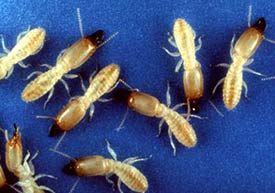Quick Links: Termite Identification Photos | Flying Ants vs. Termites | Termite Treatments | Termite Photos | New Website
You've Got a 20% Chance of Getting Termites in New Jersey This Year
One in five New Jersey homes will suffer termite damage this year. Voracious wood feeders, termites damage more than half a million homes in the U.S. every year at an annual cost of more than $5 billion. Living in massive underground colonies that can number in the tens of thousands to millions, termites feed on cellulose, the fibrous material in wood and wood products. Because of their diminutive size and subterranean habitat, termite activity is rarely discovered until after significant damage has occurred.
The Eastern Subterranean Termite is the only termite species found in New Jersey and the most prevalent termite in North America. It is one of four destructive subterranean termite species found in the U.S., including the highly aggressive Formosan "super" termite that annihilates structures in southern states, the tiny Western termite prevalent along the West Coast, and the Desert termite common in the Southwest. Two other termite species inhabit the U.S.: Dampwood termites that live in heavily forested areas, and Drywood termites, primarily a furniture pest, found along America's extreme southern border.
A mature termite colony can consume one lineal foot of 2 by 4 structural wood every 120 days. Left untreated, a large termite colony can eventually cause structural collapse. Successful elimination of termites from an infected home or business requires specialized treatment techniques that should only be performed by a highly trained and experienced termite extermination firm like Allison Pest Control.
New Jersey is Home for the Eastern Subterranean Termite
 The size of a grain of rice, Eastern Subterranean Termites have soft, white
bodies that are long, narrow, oval-shaped and about 1/8 to 1/4 inch long. Spending
their entire lives underground, subterranean termites are wingless and sightless,
communicating via pheromones. These social insects are governed by a strict
caste system, subterranean termites live in huge underground colonies that
can number in the millions. Most termites have a two-year life span but queens
and kings can live 25 to 30 years. Caste designation determines differences
in physical appearance.
The size of a grain of rice, Eastern Subterranean Termites have soft, white
bodies that are long, narrow, oval-shaped and about 1/8 to 1/4 inch long. Spending
their entire lives underground, subterranean termites are wingless and sightless,
communicating via pheromones. These social insects are governed by a strict
caste system, subterranean termites live in huge underground colonies that
can number in the millions. Most termites have a two-year life span but queens
and kings can live 25 to 30 years. Caste designation determines differences
in physical appearance.
Most colony inhabitants are small 1/8-inch workers with translucent white bodies and short legs. Workers gather food, construct tunnels, maintain the nest, and feed and groom the queen, larvae and other colony inhabitants. Soldiers, the nest's defenders, are nearly twice the size of workers, about 1/4 inch long, with elongated orange heads and fierce mandible pincers. Reproductives include the enormous 1/2-inch-long, egg-laying queen, several fertilizing male "kings" of normal size and periodic winged reproductives, or "swarmers," the prospective queens and kings of future termite colonies. Find out more about termite behavior and termite colony inhabitants.
Allison Pest Control is a NJ Termite Extermination Expert
Two methods of termite extermination are currently used in New Jersey: bait systems and exterior liquid barriers. Both methods require exacting application techniques and the use of specialized tools and termiticides available only to pest control professionals.
Termites' highly-developed self-preservation instincts make colony extermination a challenge. If termite colonies are unduly disturbed during treatment, they can divide or relocate, increasing the difficulty of successful elimination. If even a minute break occurs in an exterior barrier, termites' small size allows them to circumvent prevention barriers and continue their relentless attack on your home or business. Allison Pest Control professional exterminators have the knowledge, experience and expertise to eliminate termites from your home or business successfully. Find out more about Allison Pest Control's termite eradication techniques.












